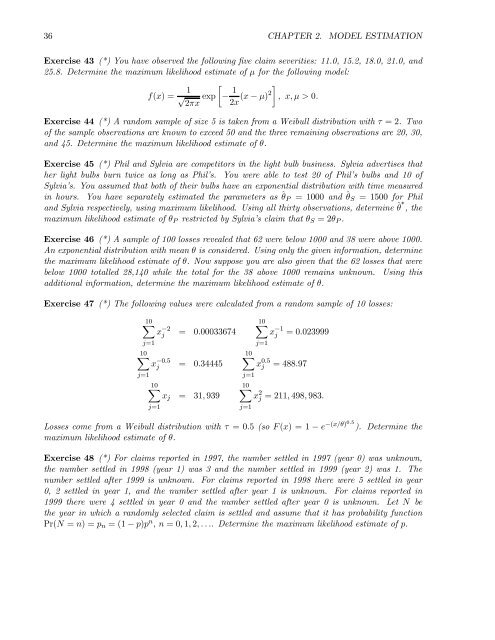Estimation, Evaluation, and Selection of Actuarial Models
Estimation, Evaluation, and Selection of Actuarial Models
Estimation, Evaluation, and Selection of Actuarial Models
You also want an ePaper? Increase the reach of your titles
YUMPU automatically turns print PDFs into web optimized ePapers that Google loves.
36 CHAPTER 2. MODEL ESTIMATION<br />
Exercise 43 (*) You have observed the following five claim severities: 11.0, 15.2, 18.0, 21.0, <strong>and</strong><br />
25.8. Determine the maximum likelihood estimate <strong>of</strong> µ for the following model:<br />
f(x) = √ 1 ·<br />
exp − 1 (x − µ)2¸<br />
, x,µ > 0.<br />
2πx 2x<br />
Exercise 44 (*) A r<strong>and</strong>om sample <strong>of</strong> size 5 is taken from a Weibull distribution with τ =2.Two<br />
<strong>of</strong> the sample observations are known to exceed 50 <strong>and</strong> the three remaining observations are 20, 30,<br />
<strong>and</strong> 45. Determine the maximum likelihood estimate <strong>of</strong> θ.<br />
Exercise 45 (*) Phil <strong>and</strong> Sylvia are competitors in the light bulb business. Sylvia advertises that<br />
her light bulbs burn twice as long as Phil’s. You were able to test 20 <strong>of</strong> Phil’s bulbs <strong>and</strong> 10 <strong>of</strong><br />
Sylvia’s. You assumed that both <strong>of</strong> their bulbs have an exponential distribution with time measured<br />
in hours. You have separately estimated the parameters as ˆθ P = 1000 <strong>and</strong> ˆθ S = 1500 for Phil<br />
<strong>and</strong> Sylvia respectively, using maximum likelihood. Using all thirty observations, determine ˆθ ∗ ,the<br />
maximum likelihood estimate <strong>of</strong> θ P restricted by Sylvia’s claim that θ S =2θ P .<br />
Exercise 46 (*) A sample <strong>of</strong> 100 losses revealed that 62 were below 1000 <strong>and</strong> 38 were above 1000.<br />
An exponential distribution with mean θ is considered. Using only the given information, determine<br />
the maximum likelihood estimate <strong>of</strong> θ. Now suppose you are also given that the 62 losses that were<br />
below 1000 totalled 28,140 while the total for the 38 above 1000 remains unknown. Using this<br />
additional information, determine the maximum likelihood estimate <strong>of</strong> θ.<br />
Exercise 47 (*) The following values were calculated from a r<strong>and</strong>om sample <strong>of</strong> 10 losses:<br />
10X<br />
j=1<br />
10X<br />
j=1<br />
10X<br />
x −2<br />
j<br />
= 0.00033674<br />
x −0.5<br />
j<br />
= 0.34445<br />
j=1<br />
x j = 31, 939<br />
10X<br />
j=1<br />
10X<br />
j=1<br />
10X<br />
j=1<br />
x −1<br />
j<br />
=0.023999<br />
x 0.5<br />
j = 488.97<br />
x 2 j = 211, 498, 983.<br />
Losses come from a Weibull distribution with τ =0.5 (so F (x) =1− e −(x/θ)0.5 ). Determine the<br />
maximum likelihood estimate <strong>of</strong> θ.<br />
Exercise 48 (*) For claims reported in 1997, the number settled in 1997 (year 0) was unknown,<br />
the number settled in 1998 (year 1) was 3 <strong>and</strong> the number settled in 1999 (year 2) was 1. The<br />
number settled after 1999 is unknown. For claims reported in 1998 there were 5 settled in year<br />
0, 2 settled in year 1, <strong>and</strong> the number settled after year 1 is unknown. For claims reported in<br />
1999 there were 4 settled in year 0 <strong>and</strong> the number settled after year 0 is unknown. Let N be<br />
the year in which a r<strong>and</strong>omly selected claim is settled <strong>and</strong> assume that it has probability function<br />
Pr(N = n) =p n =(1− p)p n ,n=0, 1, 2,.... Determine the maximum likelihood estimate <strong>of</strong> p.
















